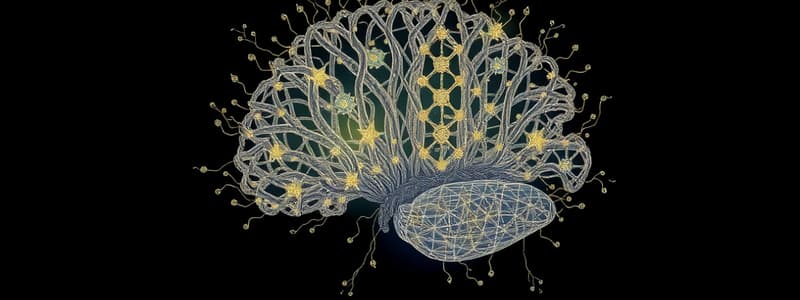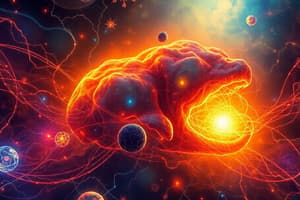Podcast
Questions and Answers
Which of the following statements accurately describes the function of the dentate gyrus in the hippocampus?
Which of the following statements accurately describes the function of the dentate gyrus in the hippocampus?
- The dentate gyrus receives input from the entorhinal cortex and projects to the CA3 region. (correct)
- The dentate gyrus is responsible for the formation of new memories and the consolidation of existing memories.
- The dentate gyrus plays a role in regulating emotional responses and stress levels.
- The dentate gyrus receives input from the CA3 region and projects to the CA1 region.
Which of the following is NOT a characteristic of Long-Term Potentiation (LTP)?
Which of the following is NOT a characteristic of Long-Term Potentiation (LTP)?
- LTP is associated with a rapid induction phase and a long-lasting maintenance phase.
- LTP can be induced by weak stimulation of a pathway if it is paired with strong stimulation of another pathway. (correct)
- LTP is specific to a particular pathway, meaning it only affects the synapses that were strongly activated.
- LTP requires simultaneous activation of presynaptic and postsynaptic neurons, adhering to Hebb's rule.
What is the role of NMDA receptors in the induction of LTP?
What is the role of NMDA receptors in the induction of LTP?
- NMDA receptors act as coincidence detectors, allowing calcium influx only when the presynaptic neuron is releasing glutamate and the postsynaptic neuron is depolarized. (correct)
- NMDA receptors directly activate protein kinases, leading to phosphorylation of downstream targets.
- NMDA receptors are responsible for the long-term maintenance of LTP by increasing the number of AMPA receptors at the synapse.
- NMDA receptors are responsible for the release of neurotransmitters from the presynaptic neuron.
Which of the following statements accurately describes the role of CA3 pyramidal neurons in the trisynaptic circuit?
Which of the following statements accurately describes the role of CA3 pyramidal neurons in the trisynaptic circuit?
Which of the following statements accurately describes the relationship between the CA1 region and the Schaffer collaterals?
Which of the following statements accurately describes the relationship between the CA1 region and the Schaffer collaterals?
What is the primary consequence of sustained low-frequency stimulation in relation to synaptic function?
What is the primary consequence of sustained low-frequency stimulation in relation to synaptic function?
Which of the following accurately describes the relationship between Ca2+ influx and LTP?
Which of the following accurately describes the relationship between Ca2+ influx and LTP?
What role do protein synthesis inhibitors play in LTP?
What role do protein synthesis inhibitors play in LTP?
What is an engram in the context of hippocampal function?
What is an engram in the context of hippocampal function?
What distinguishes long-term potentiation (LTP) from long-term depression (LTD) in terms of synaptic stimulation paradigms?
What distinguishes long-term potentiation (LTP) from long-term depression (LTD) in terms of synaptic stimulation paradigms?
Flashcards
LTP (Long-Term Potentiation)
LTP (Long-Term Potentiation)
A long-lasting enhancement in synaptic strength following high-frequency stimulation.
AMPA Receptors
AMPA Receptors
Glutamate receptors that mediate fast synaptic transmission and are inserted during LTP.
LTD (Long-Term Depression)
LTD (Long-Term Depression)
A long-lasting decrease in synaptic strength due to low-frequency stimulation.
Role of Ca2+ in LTP
Role of Ca2+ in LTP
Signup and view all the flashcards
Hippocampal Engrams
Hippocampal Engrams
Signup and view all the flashcards
Hippocampus structure
Hippocampus structure
Signup and view all the flashcards
Long-Term Potentiation (LTP)
Long-Term Potentiation (LTP)
Signup and view all the flashcards
Hebb's Rule
Hebb's Rule
Signup and view all the flashcards
Associative LTP
Associative LTP
Signup and view all the flashcards
Study Notes
Hippocampal Structure and Function
- The hippocampus, found in all mammalian orders, possesses a trisynaptic circuit with three excitatory synaptic stations.
- Input arrives from the perforant path (entorhinal cortex axons), projecting to granule cells (dentate gyrus).
- This path leads to the CA3 region via mossy fibers.
- Then, Schaffer collaterals connect CA3 to CA1.
- Other brain areas also have connections.
- Granule cells (dentate gyrus) and pyramidal neurons (CA3, CA1) are key components.
- CA3 has complex spines and projects to CA3/CA2 (associational) or CA1 (Schaffer collateral).
- CA1's stratum radiatum houses Schaffer collateral synapses with normal spines.
- This circuit is well-suited to spatial navigation, integrating context and content.
- Interneurons, including 21 types in CA1, provide crucial inhibition.
Synaptic Plasticity (LTP & LTD)
- Synaptic plasticity involves changing synaptic strength (e.g., Long-Term Potentiation and Long-Term Depression).
- Hebbian learning: Repeated activation strengthens connections (synaptic efficiency increase). Information encoding must synchronize with memory timescales.
- LTP (Long-Term Potentiation): Repeated strong activation of a synapse increases its strength. This is
- Specific: to a pathway.
- Fast: Induction occurs rapidly (seconds to minutes), sustained for hours.
- Coincidence-dependent: Synaptic activity must occur simultaneously (Hebb's rule).
- Associative LTP: Weak stimulation on one pathway can induce LTP in a different pathway if paired with strong stimulation in the first one (Pavlovian conditioning).
- LTP Mechanisms:
- NMDA receptors: act like coincidence detectors. Strong depolarization (high activity) removes Mg2+ blockage of NMDA channels.
- Ca2+ influx activates signal cascades (protein kinases like CAMKII and PKC).
- CAMKII phosphorylates downstream targets, enhancing AMPA receptor sensitivity.
- More AMPA receptors are inserted into the synapse.
- Maintenance of LTP: Requires synthesis of new proteins (LTP lasts hours). Blocking protein synthesis disrupts lasting LTP.
- LTD (Long-Term Depression): Weak or infrequent synaptic activity weakens synaptic strength.
- NMDA-dependent: Postsynaptic Ca2+ influx plays a role.
- LTD is driven by sustained low-level Ca2+ influx. Lower Ca2+ influx activates protein phosphatases, removing AMPA receptors.
- LTP and LTD Balance: High-frequency LTP and prolonged low-frequency LTD are unlikely in a physiological setting, as these require specific stimulation protocols.
Hippocampus and Memory
- Hippocampal Engrams: Synaptic plasticity forms memory engrams, ensembles of synaptically connected cells encoding specific memories.
Studying That Suits You
Use AI to generate personalized quizzes and flashcards to suit your learning preferences.




